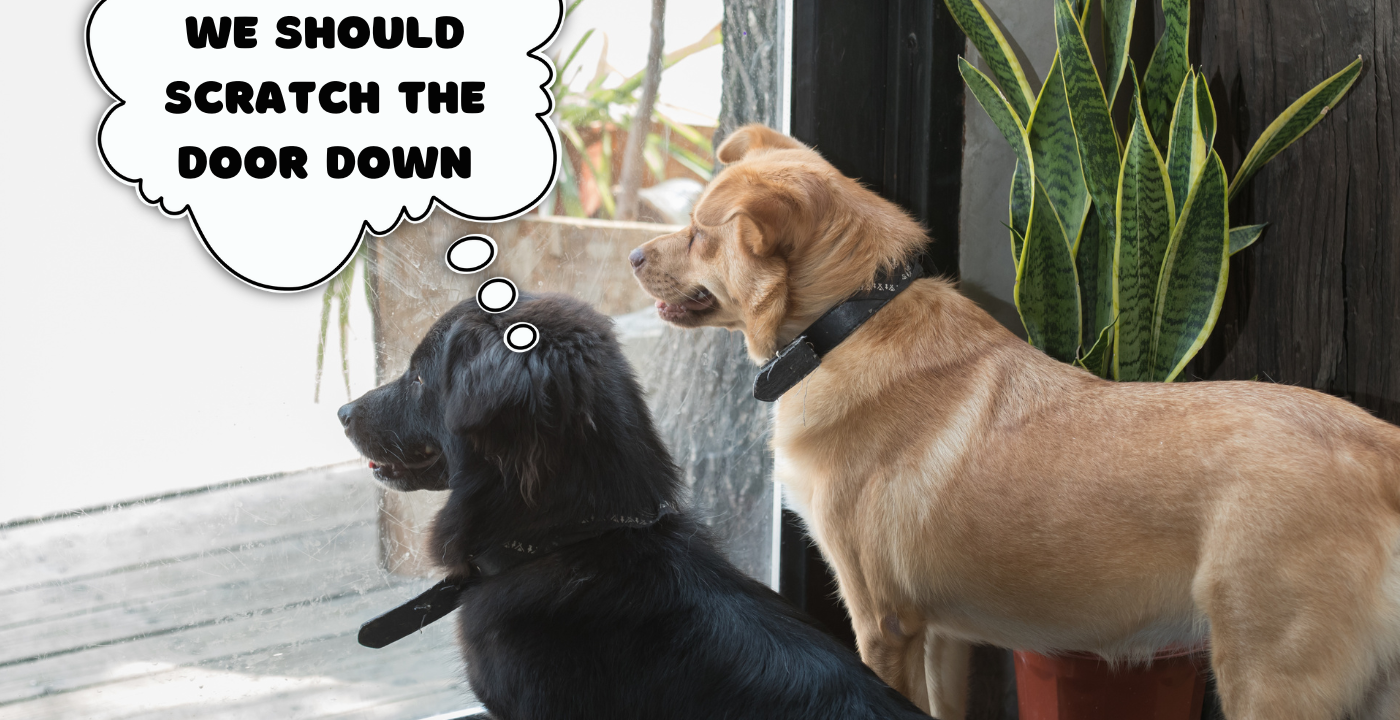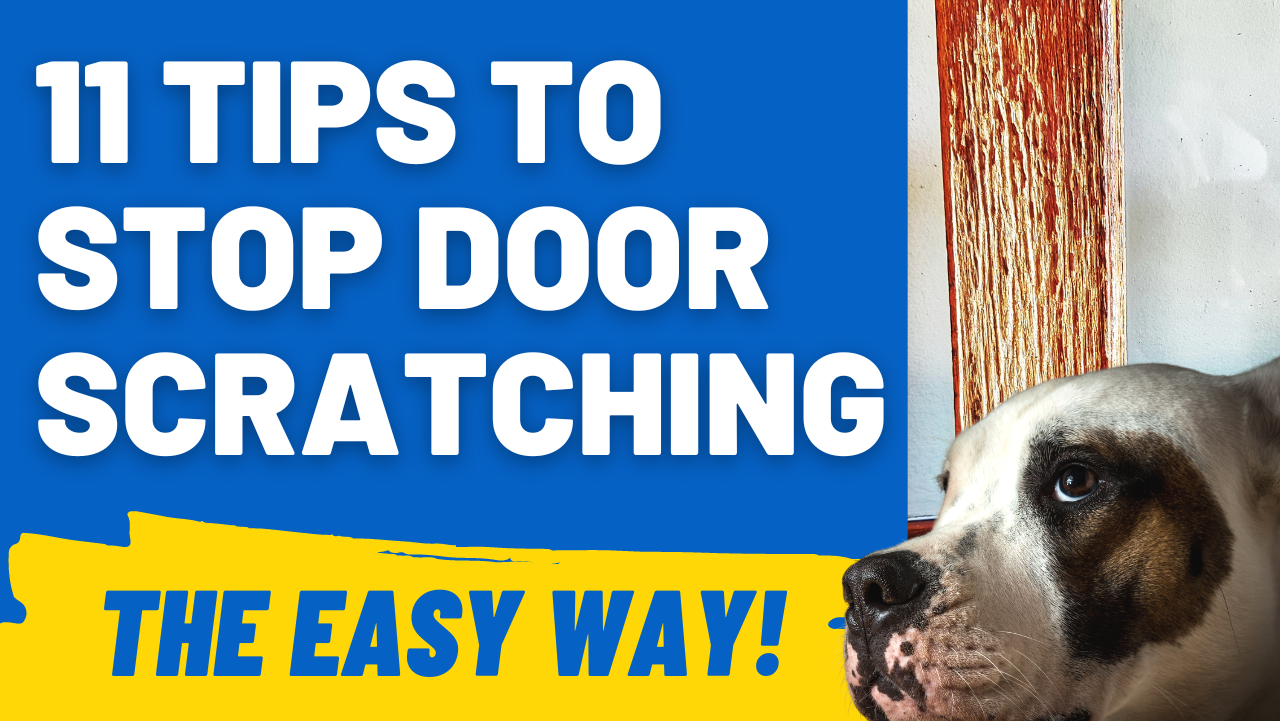Why do dogs scratch at the door? Do they think they will be able to scratch their way to the other side, or do they want to go out to do their business? Scratching at the door can be caused by various reasons, but whatever the reason is, door scratching is usually an unwanted behavior that can be addressed.
Unfortunately, whether your dog is scratching on a glass door or wood door, the door can be damaged. And your dog can also injure themselves by getting a splinter or breaking a nail. Not to mention it can definitely be annoying for you, too! So this isn’t a problem you want to ignore.
Knowing the cause of why your dog scratches at the door is the first step in resolving the problem. We’re going to give you some tips in this post, but there’s no point in doing the wrong one for your dog’s problem.
For example, if your dog scratches at the door because they need to do a wee, then giving them more exercise won’t solve the door scratching. So it’s going to be up to you to determine why your dog scratches at the door, and then use the best tip that suits that cause.
And here’s a golden rule to keep in mind: Never open the door in response to their door scratching. This reinforces the action, as they know it works and will continue to do it.
Increase Exercise
Is your dog bored and is scratching at the door so they can go for a run?
One of the first steps in getting your dog to stop scratching at the door is to increase your dog’s daily exercise. Often, scratching at the door is your dog’s way of telling you they need to let out some energy. They might be saying, ‘Dad, throw the ball for me!’ or ‘Let me go dig a hole!’.
If this is the case for you, setting expectations is important. Create a regular exercise schedule that works for you and stick to it.
Your dog will learn the schedule and will know that a good long walk or a fun game of fetch in the backyard is a part of the daily routine, and won’t feel the need to scratch at the door to remind you. But you will need to stick at this for a while until your dog unlearns that scratching the door means the door opens.
The golden rule again is to never open the door to scratching.
Set the expectations for your dog and stick to them.
Train your dog
If your dog has learned to scratch at the door to let you know they want to go outside, whether to play or go to the bathroom, you can train your dog to use another method of communication.
There are dog door bells that you can hang on the doorknob, and you can train your dog to hit the bells with their paw or nose. Then you will respond to the noise by giving a treat and letting your dog out.
There’s also this option of a door bell that you can attach to the wall or the door. Your dog will learn to push or “boop” the bell with its nose to inform you of its needs. But you will need to spend some time training this by treating and opening the door.
[/fusion_text]

Increase Mental Stimulation
Sometimes physical exercise isn’t enough, and we must exercise our dog’s brains through things like brain games. Mental stimulation can happen at any time of day, even during daily walks!
If you are walking for exercise, save the first or last part of the walk as a warm-up or cool down and allow your dog to sniff to its heart’s content.
Adding sensory enrichment is an amazing way to add a little more excitement to their day. Even if your dog wants to sniff the fire hydrant, give them to time to do so. It could be good for them and help curb unwanted behaviors in the long run.
Another way to increase mental stimulation with your dog is to play brain games and add puzzle toys to your dog’s toy chest. Puzzle toys like our Hide’n’Treat toys are great for letting your dog fine-tune their natural problem-solving abilities.
A puzzle toy can be as simple as having your dog work on getting peanut butter out of a toy. Or it can be a little more complex, like a puzzle toy with hidden compartments that your dog has to figure out how to open to get the treat out.
These are both great ways to enhance your dog’s playtime and have them think less about what’s going on outside.
Improving Separation Anxiety
In some cases, it’s not just our dogs wanting to get outside that causes them to scratch on the door. Many dogs have some form of separation anxiety and don’t want to be separated from their owners whatsoever. If you shut a door behind you to go to the bathroom or because you are in a room you don’t want your dog to be in, your dog may panic and start scratching at the door to try to get close to you.
If you simply want to keep your dog from having access to a room, you could try using a dog gate so that your dog doesn’t have access but can still see you and feel close to you.
If you are okay with having your bedroom door open at night but just don’t want your dog in there, a gate would also be a good option to stop your dog from scratching the door at night.
However, this doesn’t entirely solve the root of the problem, which is separation anxiety. For separation anxiety, you may need to try crate training. or we also have this post on separation anxiety that can help.
By placing your dog in the crate and practicing leaving the room for short spurts of time, you’ll protect your doors from getting scratched up while working on increasing your dog’s confidence in being alone.
Getting your dog to be okay alone can be a fair amount of work, but a happy and confident dog is well worth the effort.
Ignore the Unwanted Behavior
This may seem easier said than done but try ignoring and not rewarding your dog’s bad behavior. By ignoring the bad behavior, in this case, the scratching on the door, your dog will learn that this method of getting your attention is no longer effective.
If you don’t respond to your dog’s demands, chances are your pup will find another way to communicate with you.
If you know they need to go outside to do a pee or poop, then wait until they stop scratching the door for several seconds before letting them out.

Firm But Gentle Correction
Of course, punishment is never the answer when it comes to training our dogs. Instead, a firm ‘No” and redirection is the ticket to training against unwanted behaviors.
Remember that just yelling the word ‘No” at your dog will more than likely not stop the behavior and may even stress your dog out more. Instead, you’ll need to be able to follow through on your command.
If you say, ‘No,’ show your dog that you mean it by redirecting the behavior. For example, try keeping your dog on a leash and practice. If your dog starts to scratch at the door, use the leash to aid in redirection as you give a firm but gentle ‘No.’
Then have your dog come to you and do an easy behavior like ‘sit’ or ‘lay down’ that you can then reward with a treat.
Training and Commands
Similarly, other training will be essential in teaching your dog not to scratch on doors. For example, if you find your dog scratching at the door, you’ll want to first redirect your dog away from the activity and then have your dog lay down and stay.
If your dog scratches at the door after someone leaves the house, practice this technique by having them leave the house for a moment so you can ensure that your dog stays lying down inside, instead of running after the person and scratching at the door.
Then treat them. Gradually you will extend the time in which they are laying down and are away from the door.
Get a Door Protector
While this doesn’t fix the key issue, it does prevent further damage in the meantime. Consider getting a door protector to ensure your dog can’t damage your door any further.
Door protectors are typically made out of a polycarbonate material that looks crystal clear. A door protector may even deter your dog from scratching if your dog doesn’t like the feel of the material or how slippery it feels against their paws.
Keep Greetings and Farewells to a Minimum
If your dog always associates the door with people coming and going, it’s natural that they will start to get excitable and hyperfocus on the door. Instead of making a big deal when you leave, just get your things ready to go and then wait a few minutes.
Dogs often learn your routine and can tell when you are leaving. Try to switch up your routine, so your dog doesn’t immediately go into panic mode when you leave and start scratching at the door.
Similarly, don’t run to greet your dog or show how excited you are when you get home. Stay calm and don’t interact with your dog until you are away from the door and in a more appropriate area. Then go crazy!
We also have this post you might like: My Dog Won’t Greet Me: (No welcome home party)
Glass Doors
If your dog likes to scratch at a glass door, then it could also be because of what they can see on the other side that looks so enticing. Just as we cover up a window that a barking dog likes to sit at, covering a glass door (at least along the bottom half) can stop this issue.
This static black-out film might be the ticket to stopping the door scratching!
Sound Deterrent
Dogs learn through association. If they scratch the door and it opens, they associate that action with what they desire. Likewise, if they bark at someone walking past and that person continues walking and disappears, they believe they’ve done a good job! So guess what happens when someone else walks by?
So if you can associate an action they are doing with something they don’t like, you can remove the action. Using a deterrent such as an Ultrasonic Training Device (usually used for barking) at the time they scratch the door, can train them to stop doing that action.
As soon as they stop, you stop using the ultrasonic sound that is uncomfortable for them. As long as you are consistent, and also never open the door they are scratching on, you should soon stop them from doing the unwanted behavior.
Redirection
Redirection is a positive training method and should be the basis of all your dog training and correction training. How it is used is by strengthening neural pathways in your dog’s brain that feel good, and eroding the ones that don’t.
Think of it like this. A dog runs around in a circle on the lawn all day long, wearing out a pathway to dirt. You come along and divert them from a part of the circle to run around a tree, and you give them a treat every time they pass the tree.
Eventually, the dog will no longer run in the circle, and will now run around the tree. The old circle will grow back over with grass. And this is exactly what is happening in their neural pathways in the brain. The old habit pathways erode and new ones take over.
If your dog is always scratching at the door, then redirect them to a toy, or to another door, and treat them and make that new interaction exciting for them. Eventually, they will see that the other activity is more fun than the scratching door activity.
Conclusion
As with any kind of training, it takes time to teach your dog how to stop unwanted behaviors.
If the reason your dog is scratching at the door is to get outside, then it’s best to install a doggy door or to get a rope of door bells and train them to use it.
By following these easy tips you will definitely start to see an improvement in your dog’s door scratching behavior. You may even find that you and your dog will become closer thanks to spending more time together working on training, exercise, and brain games!




